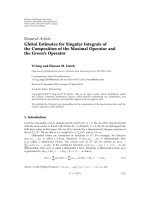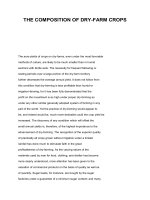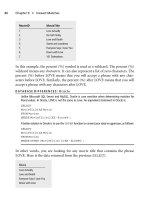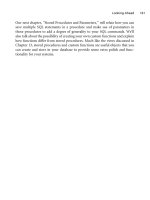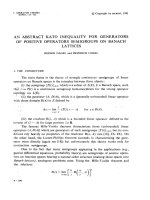THE COMPOSITION OF DRY-FARM CROPS ppsx
Bạn đang xem bản rút gọn của tài liệu. Xem và tải ngay bản đầy đủ của tài liệu tại đây (129.09 KB, 14 trang )
THE COMPOSITION OF DRY-FARM CROPS
The acre-yields of crops on dry-farms, even under the most favorable
methods of culture, are likely to be much smaller than in humid
sections with fertile soils. The necessity for frequent fallowing or
resting periods over a large portion of the dry-farm territory
further decreases the average annual yield. It does not follow from
this condition that dry-farming is less profitable than humid-or
irrigation-farming, for it has been fully demonstrated that the
profit on the investment is as high under proper dry-farming as
under any other similar generally adopted system of farming in any
part of the world. Yet the practice of dry-farming would appear to
be, and indeed would be, much more desirable could the crop yield be
increased. The discovery of any condition which will offset the
small annual yields is, therefore, of the highest importance to the
advancement of dry-farming. The recognition of the superior quality
of practically all crops grown without irrigation under a limited
rainfall has done much to stimulate faith in the great
profitableness of dry-farming. As the varying nature of the
materials used by man for food, clothing, and shelter has become
more clearly understood, more attention has been given to the
valuation of commercial products on the basis of quality as well as
of quantity. Sugar beets, for instance, are bought by the sugar
factories under a guarantee of a minimum sugar content; and many
factories of Europe vary the price paid according to the sugar
contained by the beets. The millers, especially in certain parts of
the country where wheat has deteriorated, distinguish carefully
between the flour-producing qualities of wheats from various
sections and fix the price accordingly. Even in the household,
information concerning the real nutritive value of various foods is
being sought eagerly, and foods let down to possess the highest
value in the maintenance of life are displacing, even at a higher
cost, the inferior products. The quality valuation is, in fact,
being extended as rapidly as the growth of knowledge will permit to
the chief food materials of commerce. As this practice becomes fixed
the dry-farmer will be able to command the best market prices for
his products, for it is undoubtedly true that from the point of view
of quality, dry-farm food products may be placed safely in
competition with any farm products on the markets of the world.
Proportion of plant parts
It need hardly be said, after the discussions in the preceding
chapters, that the nature of plant growth is deeply modified by the
arid conditions prevailing in dry-farming. This shows itself first
in the proportion of the various plant parts, such as roots, stems,
leaves, and seeds. The root systems of dry-farm crops are generally
greatly developed, and it is a common observation that in adverse
seasons the plants that possess the largest and most vigorous roots
endure best the drouth and burning heat. The first function of the
leaves is to gather materials for the building and strengthening of
the roots, and only after this has been done do the stems lengthen
and the leaves thicken. Usually, the short season is largely gone
before the stem and leaf growth begins, and, consequently, a
somewhat dwarfed appearance is characteristic of dry-farm crops. The
size of sugar beets, potato tubers, and such underground parts
depends upon the available water and food supply when the plant has
established a satisfactory root and leaf system. If the water and
food are scarce, a thin beet results; if abundant, a well-filled
beet may result.
Dry-farming is characterized by a somewhat short season. Even if
good growing weather prevails, the decrease of water in the soil has
the effect of hastening maturity. The formation of flowers and seed
begins, therefore, earlier and is completed more quickly under arid
than under humid conditions. Moreover, and resulting probably from
the greater abundance of materials stored in the root system, the
proportion of heads to leaves and stems is highest in dry-farm
crops. In fact, it is a general law that the proportion of heads to
straw in grain crops increases as the water supply decreases. This
is shown very well even under humid or irrigation conditions when
different seasons or different applications of irrigation water are
compared. For instance, Hall quotes from the Rothamsted experiments
to the effect that in 1879, which was a wet year (41 inches), the
wheat crop yielded 38 pounds of grain for every 100 pounds of straw;
whereas, in 1893, which was a dry year (23 inches), the wheat crop
yielded 95 pounds of grain to every 100 pounds of straw. The Utah
station likewise has established the same law under arid conditions.
In one series of experiments it was shown as an average of three
years' trial that a field which had received 22.5 inches of
irrigation water produced a wheat crop that gave 67 pounds of grain
to every 100 pounds of straw; while another field which received
only 7.5 inches of irrigation water produced a crop that gave 100
pounds of grain for every 100 pounds of straw. Since wheat is grown
essentially for the grain, such a variation is of tremendous
importance. The amount of available water affects every part of the
plant. Thus, as an illustration, Carleton states that the per cent
of meat in oats grown in Wisconsin under humid conditions was 67.24,
while in North Dakota, Kansas, and Montana, under arid and semiarid
conditions, it was 71.51. Similar variations of plant parts may be
observed as a direct result of varying the amount of available
water. In general then, it may be said that the roots of dry-farm
crops are well developed; the parts above ground somewhat dwarfed;
the proportion of seed to straw high, and the proportion of meat or
nutritive materials in the plant parts likewise high.
The water in dry-farm crops
One of the constant constituents of all plants and plant parts is
water. Hay, flour, and starch contain comparatively large quantities
of water, which can be removed only by heat. The water in green
plants is often very large. In young lucern, for instance, it
reaches 85 per cent, and in young peas nearly 90 per cent, or more
than is found in good cow's milk. The water so held by plants has no
nutritive value above ordinary water. It is, therefore, profitable
for the consumer to buy dry foods. In this particular, again,
dry-farm crops have a distinct advantage: During growth there is not
perhaps a great difference in the water content of plants, due to
climatic differences, but after harvest the drying-out process goes
on much more completely in dry-farm than in humid districts. Hay,
cured in humid regions, often contains from 12 to 20 per cent of
water; in arid climates it contains as little as 5 per cent and
seldom more than 12 per cent. The drier hay is naturally more
valuable pound for pound than the moister hay, and a difference in
price, based upon the difference in water content, is already being
felt in certain sections of the West.
The moisture content of dry-farm wheat, the chief dry-farm crop, is
even more important. According to Wiley the average water content of
wheat for the United States is 10.62 per cent, ranging from 15 to 7
per cent. Stewart and Greaves examined a large number of wheats
grown on the dry-farms of Utah and found that the average per cent
of water in the common bread varieties was 8.46 and in the durum
varieties 8.89. This means that the Utah dry-farm wheats transported
to ordinary humid conditions would take up enough water from the air
to increase their weight one fortieth, or 2.2 per cent, before they
reached the average water content of American wheats. In other
words, 1,000,000 bushels of Utah dry-farm wheat contain as much
nutritive matter as 1,025,000 bushels of wheat grown and kept under
humid conditions. This difference should be and now is recognized in
the prices paid. In fact, shrewd dealers, acquainted with the
dryness of dry-farm wheat, have for some years bought wheat from the
dry-farms at a slightly increased price, and trusted to the increase
in weight due to water absorption in more humid climates for their
profits. The time should be near at hand when grains and similar
products should be purchased upon the basis of a moisture test.
While it is undoubtedly true that dry-farm crops are naturally drier
than those of humid countries, yet it must also be kept in mind that
the driest dry-farm crops are always obtained where the summers are
hot and rainless. In sections where the precipitation comes chiefly
in the spring and summer the difference would not be so great.
Therefore, the crops raised on the Great Plains would not be so dry
as those raised in California or in the Great Basin. Yet, wherever
the annual rainfall is so small as to establish dry-farm conditions,
whether it comes in the winter or summer, the cured crops are drier
than those produced under conditions of a much higher rainfall, and
dry farmers should insist that, so far as possible in the future,
sales be based on dry matter.
The nutritive substances in crops
The dry matter of all plants and plant parts consists of three very
distinct classes of substances: First, ash or the mineral
constituents. Ash is used by the body in building bones and in
supplying the blood with compounds essential to the various life
processes. Second, protein or the substances containing the element
nitrogen. Protein is used by the body in making blood, muscle,
tendons, hair, and nails, and under certain conditions it is burned
within the body for the production of heat. Protein is perhaps the
most important food constituent. Third, non-nitrogenous substances,
including fats, woody fiber, and nitrogen-free extract, a name given
to the group of sugars, starehes, and related substances. These
substances are used by the body in the production of fat, and are
also burned for the production of heat. Of these valuable food
constituents protein is probably the most important, first, because
it forms the most important tissues of the body and, secondly,
because it is less abundant than the fats, starches, and sugars.
Indeed, plants rich in protein nearly always command the highest
prices.
The composition of any class of plants varies considerably in
different localities and in different seasons. This may be due to
the nature of the soil, or to the fertilizer applied, though
variations in plant composition resulting from soil conditions are
comparatively small. The greater variations are almost wholly the
result of varying climate and water supply. As far as it is now
known the strongest single factor in changing the composition of
plants is the amount of water available to the growing plant.
Variations due to varying water supply
The Utah station has conducted numerous experiments upon the effect
of water upon plant composition. The method in every case has been
to apply different amounts of water throughout the growing season on
contiguous plats of uniform land. [Lengthy table deleated from this
edition.] Even a casual study of . . . [the results show] that the
quantity of water used influenced the composition of the plant
parts. The ash and the fiber do not appear to be greatly influenced,
but the other constituents vary with considerable regularity with
the variations in the amount of irrigation water. The protein shows
the greatest variation. As the irrigation water is increased, the
percentage of protein decreases. In the case of wheat the variation
was over 9 per cent. The percentage of fat and nitrogen-free
extract, on the other hand, becomes larger as the water increases.
That is, crops grown with little water, as in dry-farming, are rich
in the important flesh-and blood-forming substance protein, and
comparatively poor in fat, sugar, stareh, and other of the more
abundant heat and fat-producing substances. This difference is of
tremendous importance in placing dry-farming products on the food
markets of the world. Not only seeds, tubers, and roots show this
variation, but the stems and leaves of plants grown with little
water are found to contain a higher percentage of protein than those
grown in more humid climates.
The direct effect of water upon the composition of plants has been
observed by many students. For instance, Mayer, working in Holland,
found that, in a soil containing throughout the season 10 per cent
of water, oats was produced containing 10.6 per cent of protein; in
soil containing 30 per cent of water, the protein percentage was
only 5.6 per cent, and in soil containing 70 per cent of water, it
was only 5.2 per cent. Carleton, in a study of analyses of the same
varieties of wheat grown in humid and semi-arid districts of the
United States, found that the percentage of protein in wheat from
the semiarid area was 14.4 per cent as against 11.94 per cent in the
wheat from the humid area. The average protein content of the wheat
of the United States is a little more than 12 per cent; Stewart and
Greaves found an average of 16.76 per cent of protein in Utah
dry-farm wheats of the common bread varieties and 17.14 per cent in
the durum varieties. The experiments conducted at Rothamsted,
England, as given by Hall, confirm these results. For example,
during 1893, a very dry year, barley kernels contained 12.99 per
cent of protein, while in 1894, a wet, though free-growing year, the
barley contained only 9.81 per cent of protein. Quotations might be
multiplied confirming the principle that crops grown with little
water contain much protein and little heat-and fat-producing
substances.
Climate and composition
The general climate, especially as regards the length of the growing
season and naturally including the water supply, has a strong effect
upon the composition of plants. Carleton observed that the same
varieties of wheat grown at Nephi, Utah, contained 16.61 per cent
protein; at Amarillo, Texas, 15.25 per cent; and at McPherson,
Kansas, a humid station, 13.04 per cent. This variation is
undoubtedly due in part to the varying annual precipitation but,
also, and in large part, to the varying general climatic conditions
at the three stations.
An extremely interesting and important experiment, showing the
effect of locality upon the composition of wheat kernels, is
reported by LeClerc and Leavitt. Wheat grown in 1905 in Kansas was
planted in 1906 in Kansas, California, and Texas In 1907 samples of
the seeds grown at these three points were planted side by side at
each of the three states All the crops from the three localities
were analyzed separately each year.
The results are striking and convincing. The original seed grown in
Kansas in 1905 contained 16.22 per cent of protein. The 1906 crop
grown from this seed in Kansas contained 19.13 per cent protein; in
California, 10.38 percent; and in Texas, 12.18 percent. In 1907 the
crop harvested in Kansas from the 1906 seed from these widely
separated places and of very different composition contained
uniformly somewhat more than 22 per cent of protein; harvested in
California, somewhat more than 11 per cent; and harvested in Texas,
about 18 per cent. In short, the composition of wheat kernels is
independent of the composition of the seed or the nature of the
soil, but depends primarily upon the prevailing climatic conditions,
including the water supply. The weight of the wheat per bushel, that
is, the average size and weight of the wheat kernel, and also the
hardness or flinty character of the kernels, were strongly affected
by the varying climatic conditions. It is generally true that
dry-farm grain weighs more per bushel than grain grown under humid
conditions; hardness usually accompanies a high protein content and
is therefore characteristic of dry-farm wheat. These notable lessons
teach the futility of bringing in new seed from far distant places
in the hope that better and larger crops may be secured. The
conditions under which growth occurs determine chiefly the nature of
the crop. It is a common experience in the West that farmers who do
not understand this principle send to the Middle West for seed corn,
with the result that great crops of stalks and leaves with no ears
are obtained. The only safe rule for the dry-farmer to follow is to
use seed which has been grown for many years under dry-farm
conditions.
A reason for variation in composition
It is possible to suggest a reason for the high protein content of
dry-farm crops. It is well known that all plants secure most of
their nitrogen early in the growing period. From the nitrogen,
protein is formed, and all young plants are, therefore, very rich in
protein. As the plant becomes older, little more protein is added,
but more and more carbon is taken from the air to form the fats,
starches, sugars, and other non-nitrogenous substances.
Consequently, the proportion or percentage of protein becomes
smaller as the plant becomes older. The impelling purpose of the
plant is to produce seed. Whenever the water supply begins to give
out, or the season shortens in any other way, the plant immediately
begins to ripen. Now, the essential effect of dry-farm conditions is
to shorten the season; the comparatively young plants, yet rich in
protein, begin to produce seed; and at harvest, seed, and leaves,
and stalks are rich in the flesh-and blood-forming element of
plants. In more humid countries plants delay the time of seed
production and thus enable the plants to store up more carbon and
thus reduce the percent of protein. The short growing season,
induced by the shortness of water, is undoubtedly the main reason
for the higher protein content and consequently higher nutritive
value of all dry-farm crops.
Nutritive value of dry-farm hay, straw, and flour
All the parts of dry-farm crops are highly nutritious. This needs to
be more clearly understood by the dry-farmers. Dry-farm hay, for
instance, because of its high protein content, may be fed with crops
not so rich in this element, thereby making a larger profit for the
farmer. Dry-farm straw often has the feeding value of good hay, as
has been demonstrated by analyses and by feeding tests conducted in
times of hay scarcity. Especially is the header straw of high
feeding value, for it represents the upper and more nutritious ends
of the stalks. Dry-farm straw, therefore, should be carefully kept
and fed to animals instead of being scattered over the ground or
even burned as is too often the case. Only few feeding experiments
having in view the relative feeding value of dry-farm crops have as
yet been made, but the few on record agree in showing the superior
value of dry-farm crops, whether fed singly or in combination.
The differences in the chemical composition of plants and plant
products induced by differences in the water-supply and climatic
environment appear in the manufactured products, such as flour,
bran, and shorts. Flour made from Fife wheat grown on the dry-farms
of Utah contained practically 16 per cent of protein, while flour
made from Fife wheat grown in Lorraine and the Middle West is
reported by the Maine Station as containing from 13.03 to 13.75 per
cent of protein. Flour made from Blue Stem wheat grown on the Utah
dry-farms contained 15.52 per cent of protein; from the same variety
grown in Maine and in the Middle West 11.69 and 11.51 per cent of
protein respectively. The moist and dry gluten, the gliadin and the
glutenin, all of which make possible the best and most nourishing
kinds of bread, are present in largest quantity and best proportion
in flours made from wheats grown under typical dry-farm conditions.
The by-products of the milling process, likewise, are rich in
nutritive elements.
Future Needs
It has already been pointed out that there is a growing tendency to
purchase food materials on the basis of composition. New discoveries
in the domains of plant composition and animal nutrition and the
improved methods of rapid and accurate valuation will accelerate
this tendency. Even now, manufacturers of food products print on
cartons and in advertising matter quality reasons for the superior
food values of certain articles. At least one firm produces two
parallel sets of its manufactured foods, one for the man who does
hard physical labor, and the other for the brain worker. Quality, as
related to the needs of the body, whether of beast or man, is
rapidly becoming the first question in judging any food material.
The present era of high prices makes this matter even more
important.
In view of this condition and tendency, the fact that dry-farm
products are unusually rich in the most valuable nutritive materials
is of tremendous importance to the development of dry-farming. The
small average yields of dry-farm crops do not look so small when it
is known that they command higher prices per pound in competition
with the larger crops of more humid climates. More elaborate
investigations should be undertaken to determine the quality of
crops grown in different dry-farm districts. As far as possible each
section, great or small, should confine itself to the growing of a
variety of each crop yielding well and possessing the highest
nutritive value. In that manner each section of the great dry-farm
territory would soon come to stand for some dependable special
quality that would compel a first-class market. Further, the
superior feeding value of dry-farm products should be thoroughly
advertised among the consumers in order to create a demand on the
markets for a quality valuation. A few years of such systematic
honest work would do much to improve the financial basis of
dry-farming.
